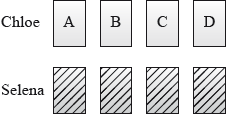| Date | November 2017 | Marks available | 3 | Reference code | 17N.1.hl.TZ0.10 |
| Level | HL only | Paper | 1 | Time zone | TZ0 |
| Command term | Determine | Question number | 10 | Adapted from | N/A |
Question
Chloe and Selena play a game where each have four cards showing capital letters A, B, C and D.
Chloe lays her cards face up on the table in order A, B, C, D as shown in the following diagram.

Selena shuffles her cards and lays them face down on the table. She then turns them over one by one to see if her card matches with Chloe’s card directly above.
Chloe wins if no matches occur; otherwise Selena wins.
Chloe and Selena repeat their game so that they play a total of 50 times.
Suppose the discrete random variable X represents the number of times Chloe wins.
Show that the probability that Chloe wins the game is \(\frac{3}{8}\).
Determine the mean of X.
Determine the variance of X.
Markscheme
METHOD 1
number of possible “deals” \( = 4! = 24\) A1
consider ways of achieving “no matches” (Chloe winning):
Selena could deal B, C, D (ie, 3 possibilities)
as her first card R1
for each of these matches, there are only 3 possible combinations for the remaining 3 cards R1
so no. ways achieving no matches \( = 3 \times 3 = 9\) M1A1
so probability Chloe wins \( = \frac{9}{{23}} = \frac{3}{8}\) A1AG
METHOD 2
number of possible “deals” \( = 4! = 24\) A1
consider ways of achieving a match (Selena winning)
Selena card A can match with Chloe card A, giving 6 possibilities for this happening R1
if Selena deals B as her first card, there are only 3 possible combinations for the remaining 3 cards. Similarly for dealing C and dealing D R1
so no. ways achieving one match is \( = 6 + 3 + 3 + 3 = 15\) M1A1
so probability Chloe wins \( = 1 - \frac{{15}}{{24}} = \frac{3}{8}\) A1AG
METHOD 3
systematic attempt to find number of outcomes where Chloe wins (no matches)
(using tree diag. or otherwise) M1
9 found A1
each has probability \(\frac{1}{4} \times \frac{1}{3} \times \frac{1}{2} \times 1\) M1
\( = \frac{1}{{24}}\) A1
their 9 multiplied by their \(\frac{1}{{24}}\) M1A1
\( = \frac{3}{8}\) AG
[6 marks]
\(X \sim {\text{B}}\left( {50,{\text{ }}\frac{3}{8}} \right)\) (M1)
\(\mu = np = 50 \times \frac{3}{8} = \frac{{150}}{8}{\text{ }}\left( { = \frac{{75}}{4}} \right){\text{ }}( = 18.75)\) (M1)A1
[3 marks]
\({\sigma ^2} = np(1 - p) = 50 \times \frac{3}{8} \times \frac{5}{8} = \frac{{750}}{{64}}{\text{ }}\left( { = \frac{{375}}{{32}}} \right){\text{ }}( = 11.7)\) (M1)A1
[2 marks]

